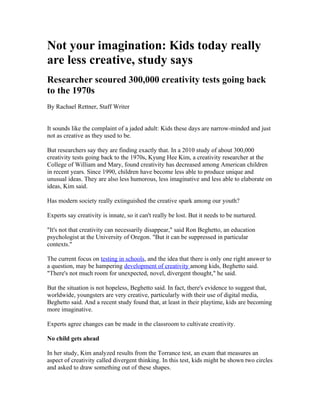
Kids Less Creative Study Finds
- 1. Not your imagination: Kids today really are less creative, study says Researcher scoured 300,000 creativity tests going back to the 1970s By Rachael Rettner, Staff Writer It sounds like the complaint of a jaded adult: Kids these days are narrow-minded and just not as creative as they used to be. But researchers say they are finding exactly that. In a 2010 study of about 300,000 creativity tests going back to the 1970s, Kyung Hee Kim, a creativity researcher at the College of William and Mary, found creativity has decreased among American children in recent years. Since 1990, children have become less able to produce unique and unusual ideas. They are also less humorous, less imaginative and less able to elaborate on ideas, Kim said. Has modern society really extinguished the creative spark among our youth? Experts say creativity is innate, so it can't really be lost. But it needs to be nurtured. "It's not that creativity can necessarily disappear," said Ron Beghetto, an education psychologist at the University of Oregon. "But it can be suppressed in particular contexts." The current focus on testing in schools, and the idea that there is only one right answer to a question, may be hampering development of creativity among kids, Beghetto said. "There's not much room for unexpected, novel, divergent thought," he said. But the situation is not hopeless, Beghetto said. In fact, there's evidence to suggest that, worldwide, youngsters are very creative, particularly with their use of digital media, Beghetto said. And a recent study found that, at least in their playtime, kids are becoming more imaginative. Experts agree changes can be made in the classroom to cultivate creativity. No child gets ahead In her study, Kim analyzed results from the Torrance test, an exam that measures an aspect of creativity called divergent thinking. In this test, kids might be shown two circles and asked to draw something out of these shapes.
- 2. Interestingly, scores on the Torrance test have been decreasing while SAT scores are increasing. However, better test scores do not necessarly translate to improved creativity, Kim said. You can do well on a test by studying a lot, but it won't encourage original thinking. Kim said No Child Left Behind, an act of Congress passed in 2001 that requires schools to administer annual standardized tests as a way to assess whether they are meeting state education standards, may be partly responsible for the drop in creativity scores. "I believe No Child Left Behind … really hurt creativity," Kim said. "If we just focus on just No Child Left Behind — testing, testing, testing — then how can creative students survive?" Kim said. Other culprits may be the rise in TV watching, a passive activity that doesn't require interactions with others, Kim said. Kim's work has also shown creativity declines in adulthood as we become more aware of the notions of right and wrong answers, she said. But just because we are doomed to become less imaginative as adults does not mean society shouldn't work to salvage creativity in children. After all, ideas in childhood may lead to future career pursuits. "If this trend continues then students who look different, nonconformists, will suffer, because they are not accepted," Kim said. Research shows that if creative personalities don't adjust to the school system, they can become underachievers and drop out of school, she said. Time to play Kids also nurture their creativity abilities when they "pretend," said Sandra Russ, a psychologist at Case Western University in Cleveland, Ohio, who was not involved in Kim's study. Elements of insight, fantasy and emotional expression all go into this type of story-making, Russ said. Nowadays, with kids' overbooked schedules, there is less time for pretend play, Russ said. Russ looked back at studies she has conducted on pretend play since 1985. In all, the studies involved close to 900 children ages 6 to 9, who were asked to make up a story using two puppets. Stories were rated based on how many ideas the kids came up with, the novelty of the ideas, and the emotions expressed within the tales. Russ found that, over time, imagination in the stories increased, with the stories in 1985 showing significantly less imagination than stories (created by different groups of kids) in 2008.
- 3. "Given the changes in [our] culture, we were surprised, and I would say encouraged," Russ said. The results suggest kids are resilient, and may be finding ways to develop these abilities through other means besides strict playtime. For instance, some video games call for creative problem-solving strategies, Russ said. The results do not necessarily contradict Kim's findings. The researchers can't be sure whether kids will actually apply their playtime imagination to the real world, Russ said. Hide and seek So how can we make sure not to squelch kids' creativity once they step inside a classroom? Beghetto said the interaction between students and teachers has become one of "intellectual hide and seek." The students try to match what they think the teacher wants to hear. "If you can do that, you can be 'successful' in school," Beghetto said. Teachers don't spend a lot of time exploring unexpected ideas because they might not be sure where it will lead, Beghetto said. As a result, "out-of-the-box" thinking gets discouraged. Beghetto is not blaming teachers, who may even feel as though they cannot teach creativity. But teaching to prepare for tests and teaching to develop creativity are not mutually exclusive, Beghetto said. Teachers should recognize that unexpected answers may still lead to meaningful conversation and learning in a classroom, he said. And schools may be able to implement tests that assess students broadly and allow for more creativity. "I think there should be a variety of ways to assess what students know and how they know it," Beghetto said.
